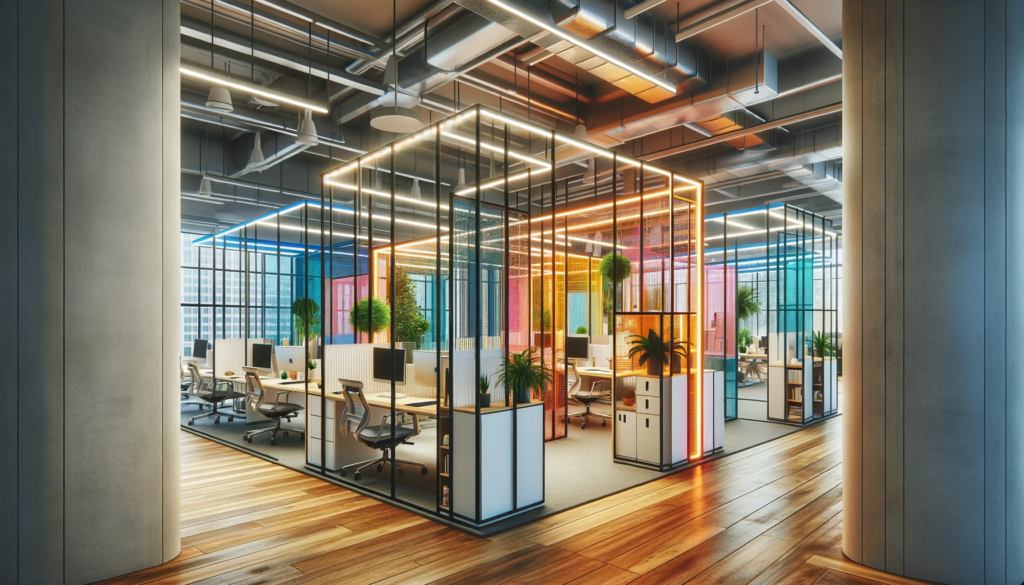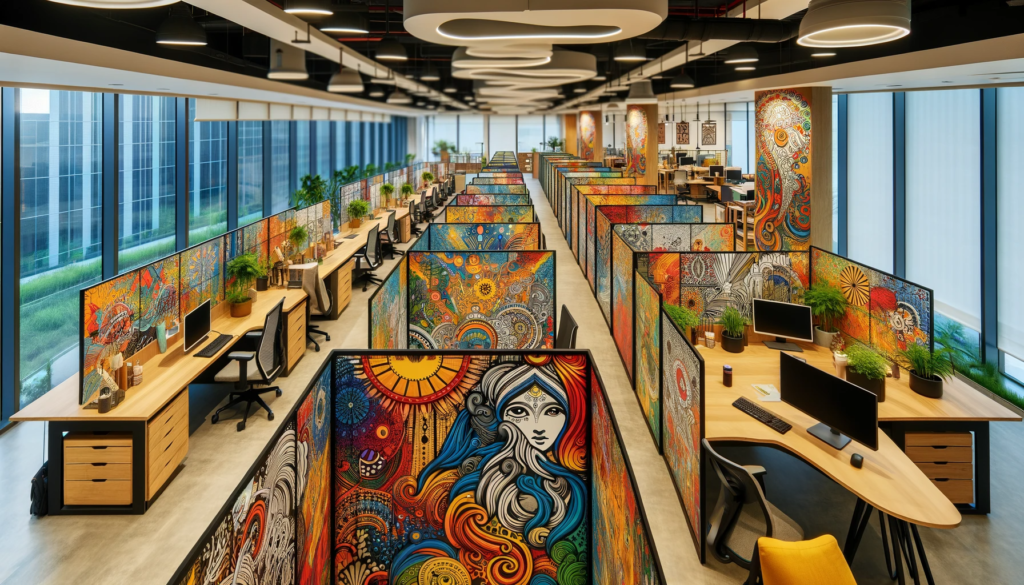In today’s dynamic business world, the layout of a workspace goes beyond mere visual appeal; it’s a crucial factor that significantly affects productivity, employee morale, and the overarching culture of a company. Let’s talk about commercial room dividers – the often overlooked yet pivotal elements in office design. Forget the old days when dividers were just practical necessities; now, they are vital for fostering workspace innovation.
These adaptable structures blend functionality with aesthetic charm, empowering businesses to create environments that are both effective and welcoming. Commercial room dividers do more than just enhance privacy without compromising the sense of community; they also break up the dullness of conventional office designs, offering a fresh perspective on workspace utilization.
This article explores the influential role of these dividers in contemporary workspaces, highlighting how they do more than just separate areas. They are key in harmonizing practicality with flair in modern office settings, thus reshaping our understanding and use of work environments.

The Evolution of Workspace Design
Over time, the idea of an office space has evolved dramatically, mirroring wider changes in work culture and technological progress. Initially, the goal was to make the most of available space, leading to the widespread use of cubicles and static desks. This design, dominant in the late 20th century, aimed to use floor space efficiently and boost individual productivity, though it sometimes did so at the expense of teamwork and employee well-being.
With the dawn of the 21st century, the focus gradually shifted towards fostering more collaborative and adaptable workspaces. The rise of open-plan offices signified this shift, encouraging a more engaging and fluid work environment. However, these open spaces, while promoting improved communication and collaboration, introduced new challenges, such as noise distractions and a decrease in privacy.
This is the context in which commercial room dividers became increasingly important. As a solution to the drawbacks of both cubicles and open layouts, these dividers provided a balanced approach. They enabled the creation of semi-private areas within an open space, offering individuals a sense of personal space while preserving a sense of openness and approachability.
Modern dividers are more than mere functional barriers; they are symbols of design and culture. They represent the contemporary workplace’s ideals of adaptability, collaboration, and individuality. By allowing for quick and easy space reconfiguration, these dividers cater to a range of needs and work styles, from solitary tasks to group brainstorming.
Furthermore, the aesthetic value of these dividers has gained prominence. Ranging from minimalist glass partitions to colorful, sound-absorbing panels, they significantly enhance the visual and acoustic quality of an office. This shift from simple utility to key design elements mirrors a wider realization: the environment of a workspace directly influences employee creativity, contentment, and productivity.
Types of Commercial Room Dividers
Commercial room dividers have developed to meet various needs in workspaces, including temporary and more permanent solutions. Recognizing the different types available is crucial for choosing the appropriate option for any workspace.
Portable Dividers: Tailored for adaptability and easy movement, these dividers are perfect for evolving workspaces. They can be swiftly moved to set up spontaneous meeting zones or secluded work areas. Typically lightweight and equipped with casters, portable dividers are ideal for offices that often rearrange their layouts.
Fixed Dividers: These dividers offer a lasting solution and are commonly used to establish distinct areas within an office. Available in diverse materials like wood, glass, or metal, fixed dividers are usually custom-made to suit particular spaces. They are particularly suited for larger offices needing consistent, long-term division of space.
Glass Dividers: Merging practicality with contemporary design, glass dividers provide separation while preserving a sense of openness. They are excellent for forming transparent meeting rooms or executive spaces, allowing natural light to flow through and create a brighter, inviting atmosphere.
Modular Dividers: These dividers are the epitome of customization. Made up of interconnecting panels or modules, they can be arranged in numerous configurations to meet different requirements. Modular dividers are especially valuable in team-oriented spaces, adaptable for varying group sizes and functions.
Acoustic Dividers: Essential in lively office settings, these dividers are designed to minimize noise. Constructed from materials that absorb sound, they help to lessen ambient noise and foster more concentrated work areas. They are particularly useful in open-plan offices where sound can propagate easily.
Decorative Dividers: These dividers add more than just functionality; they also serve as ornamental elements. With choices ranging from printed fabric to elaborate wooden designs, they can elevate the visual appeal of an office, reflecting its culture and brand.
Each type of divider fulfills a specific role and can be chosen based on criteria such as mobility, permanence, transparency, adaptability, sound reduction, and visual impact. The right mix of these dividers can turn a regular office into a multifunctional, aesthetically pleasing workspace, addressing the varied demands of contemporary businesses and their employees.

Benefits of Using Commercial Room Dividers
Commercial room dividers offer a range of benefits in the workplace, transcending their role as mere physical separators. Here’s a look at some of their key advantages:
Privacy and Concentration Enhancement: In our fast-moving work settings, finding focus can be a challenge. Room dividers are an effective way to create private areas that lessen interruptions. This is especially important for tasks that need intense concentration or privacy.
Noise Reduction: The buzz of open-plan offices can hinder productivity. Acoustic dividers help in dampening sound, leading to a quieter and more peaceful workspace. This allows for better communication and concentration among employees.
Adaptable Space Utilization: Today’s workplaces need to be versatile to accommodate shifting demands and functions. Commercial room dividers enable quick and efficient rearrangement of spaces. Whether it’s for setting up a pop-up meeting space or dividing a larger area for specific projects, dividers make space management flexible.
Cost-Efficiency: Altering office structures permanently or remodeling can be expensive and disruptive. Room dividers are a budget-friendly alternative, offering the advantages of structural changes without the hefty expense and extensive construction time.
Aesthetic Enhancement: Room dividers are not just functional; they also add to the visual appeal of a workspace. With a variety of styles, colors, and materials available, they can enhance office decor, reflecting the company’s brand and ethos. An appealing workspace can lift spirits and make a favorable impression on clients and visitors.
Workflow Optimization and Collaboration: Strategic placement of room dividers can help organize work areas to improve workflow and encourage teamwork. Designated spaces for teams to collaborate can be set up without impacting others, leading to a more cooperative and productive work environment.
Health and Safety Measures: In times where health considerations like social distancing are important, room dividers become essential. They aid in creating safer work areas by providing barriers that reduce physical contact and uphold hygiene standards.
Eco-Friendly Options: Many contemporary dividers are crafted from sustainable materials, matching the increasing focus on environmental responsibility in the workplace. This not only lessens the ecological impact but also promotes a healthier indoor environment for staff.
Case Study / Real-World Examples
Background and Context
Located in the bustling hub of Silicon Valley, an emerging tech startup was gaining attention for its innovative approach to software development. With the team expanding, their workspace needs grew as well. They sought an environment that supported their collaborative ethos and could adapt to their constantly changing project needs. A key challenge was finding the right balance between open areas for team collaboration and quiet spaces for focused, individual tasks. The startup’s vibrant setting demanded a versatile solution that would enhance both productivity and creativity.
Solution Implementation
The startup chose to integrate a combination of modular and acoustic commercial room dividers. The modular dividers became a pivotal feature, enabling the creation of flexible ‘collaboration pods.’ These pods could be swiftly modified, resized, or restructured to align with the team’s size and project necessities, perfectly suiting the startup’s dynamic work approach. To cater to the need for quieter zones, acoustic dividers were strategically placed around individual workstations. Selected for their sound-absorbing qualities, these dividers effectively reduced office noise, establishing serene spaces amidst the active workplace.
Resulting Benefits
The impact of this transformation was significant. The modular dividers cultivated an adaptable workspace, facilitating unrestrained teamwork. The acoustic dividers, meanwhile, offered essential areas of concentration and privacy, imperative for tasks demanding intense focus or confidential discussions. This combination achieved an ideal equilibrium, creating a workspace that was both vibrant and conducive to productivity. The staff reported a notable uptick in satisfaction, appreciating the improved versatility and the new harmony between collaborative and private work areas. Additionally, the startup experienced an increase in team productivity and a boost in creative outcomes, reinforcing their reputation as an innovative force in the tech sector.

Conclusion
The examination of commercial room dividers across different workplace contexts highlights their essential role in contemporary office design. Our insights from real-world examples and the variety of dividers available reveal that these elements are more than just practical tools. They play a crucial role in shaping workspaces that are flexible, efficient, and visually appealing.
In a time when the nature of work is continuously changing, the adaptability provided by these dividers is priceless. They meet a wide range of workplace requirements – from increasing privacy and minimizing noise, to fostering dynamic teamwork areas and enhancing the overall visual environment. The case studies, including the tech startup and the law firm, clearly illustrate the transformative impact of well-selected and smartly positioned dividers. They effectively balance the needs for privacy and collaborative interaction, while nurturing a positive workplace atmosphere.
Furthermore, the trend towards using sustainable materials and integrating technology into room dividers shows a more profound appreciation of the role of the modern workspace. It’s recognized not only as a business venue but also as a space contributing to employee well-being and environmental stewardship.